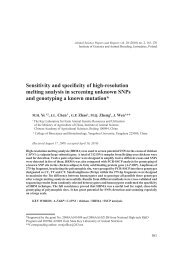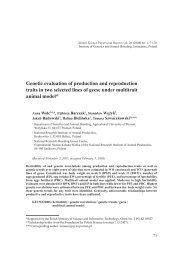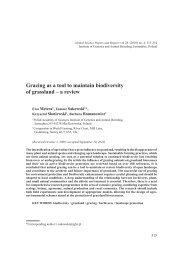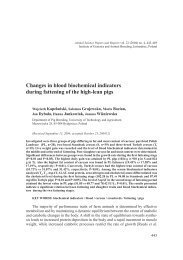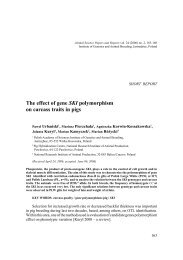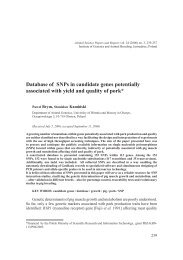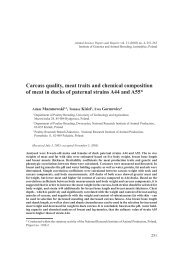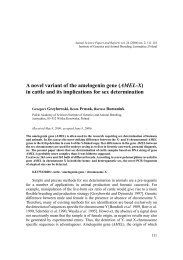SRY-negative, 64,XX sex reversal in a Konik Polski horse: a case ...
SRY-negative, 64,XX sex reversal in a Konik Polski horse: a case ...
SRY-negative, 64,XX sex reversal in a Konik Polski horse: a case ...
You also want an ePaper? Increase the reach of your titles
YUMPU automatically turns print PDFs into web optimized ePapers that Google loves.
Animal Science Papers and Reports vol. 28 (2010) no. 4, 381-388<br />
Institute of Genetics and Animal Breed<strong>in</strong>g, Jastrzębiec, Poland<br />
<strong>SRY</strong>-<strong>negative</strong>, <strong>64</strong>,<strong>XX</strong> <strong>sex</strong> <strong>reversal</strong><br />
<strong>in</strong> a <strong>Konik</strong> <strong>Polski</strong> <strong>horse</strong>: a <strong>case</strong> report<br />
Kazimierz Jaszczak 1 *, Paweł Sysa 2 , Mariusz Sacharczuk 1 , Rafal Parada 1 ,<br />
Katarzyna Romanowicz 3 , Magdalena Kawka 1 , Wiesław Jarmuż 1<br />
1<br />
Department of Molecular Cytogenetics, Polish Academy of Sciences<br />
Institute of Genetics and Animal Breed<strong>in</strong>g,<br />
Jastrzębiec, 05-552 Wólka Kosowska, Poland<br />
2<br />
Faculty of Veter<strong>in</strong>ary Medic<strong>in</strong>e, Warsaw University of Life Sciences,<br />
Nowoursynowska 159, 02-776 Warsaw, Poland<br />
3<br />
Department of Endocr<strong>in</strong>ology, The Kielanowski Institute of Animal Physiology and Nutrition,<br />
Polish Academy of Sciences, 05-110 Jablonna, Instytucka 3, Poland<br />
(Received March 18, 2010; accepted July 8, 2010)<br />
A three-years old <strong>Konik</strong> <strong>Polski</strong> (Polish Primitive Horse) <strong>in</strong>dividual was diagnosed as hav<strong>in</strong>g <strong>XX</strong> <strong>sex</strong><br />
<strong>reversal</strong> syndrome on the basis of female karyotype <strong>64</strong>,<strong>XX</strong>, and the presence of two <strong>in</strong>ter-abdom<strong>in</strong>al<br />
testes and ambiguous external genitals The <strong>in</strong>dividual exhibited aggressive, stallion-like behaviour.<br />
The PCR analysis of the <strong>SRY</strong> gene revealed the absence of the Y chromosome sequences <strong>SRY</strong> <strong>in</strong><br />
DNA extracted from blood, gonads, sk<strong>in</strong> and liver. This is the first reported <strong>case</strong> of an <strong>SRY</strong>-<strong>negative</strong><br />
<strong>XX</strong>- male <strong>sex</strong> <strong>reversal</strong> <strong>in</strong> a <strong>Konik</strong> <strong>Polski</strong> <strong>horse</strong> suggest<strong>in</strong>g that it is sporadic <strong>case</strong> rather and not a<br />
familial occurrence.<br />
KEY WORDS: <strong>SRY</strong>-<strong>negative</strong> / <strong>sex</strong> <strong>reversal</strong> / <strong>Konik</strong> <strong>Polski</strong> <strong>horse</strong><br />
<strong>SRY</strong>-<strong>negative</strong> <strong>XX</strong> <strong>sex</strong> <strong>reversal</strong> is a disorder of gonadal development where<br />
<strong>in</strong>dividuals hav<strong>in</strong>g female <strong>64</strong>,<strong>XX</strong> karyotype <strong>in</strong> the absence of the <strong>SRY</strong> gene (<strong>sex</strong><br />
determ<strong>in</strong><strong>in</strong>g region on the Y chromosome) develop testes or ovotestes. Such<br />
<strong>in</strong>dividuals can be <strong>XX</strong> males or <strong>XX</strong> true hermaphrodites and are <strong>in</strong>fertile. <strong>SRY</strong>-<br />
*Correspond<strong>in</strong>g author: k.jaszczak@ighz.pl<br />
381
K. Jaszczak et al.<br />
<strong>negative</strong> <strong>XX</strong> <strong>sex</strong> <strong>reversal</strong> syndrome was reported <strong>in</strong> numerous species of mammals<br />
[Vaiman and Pailhoux 2000]. The syndrome was diagnosed <strong>in</strong> at least 18 can<strong>in</strong>e<br />
breeds [Meyers-Wallen 2006], <strong>in</strong> goats [Pailhoux et al. 2001a], and pigs [Pailhoux et<br />
al.1994, Pailhoux et al. 2001b,c]. Such a type of <strong>in</strong>ter<strong>sex</strong>uality was also recognized <strong>in</strong><br />
several breeds of <strong>horse</strong>s [Milliken et al. 1995, Meyers-Wallen et al. 1997, Bouen et<br />
al. 2000, Vaughan et al. 2001, Bannasch et al. 2007]. It was shown that <strong>SRY</strong>-<strong>negative</strong><br />
<strong>XX</strong> <strong>sex</strong> <strong>reversal</strong> <strong>in</strong> mammals is caused by an autosomal recessive gene and may be<br />
an <strong>in</strong>herited disorder [Buoen et al. 2000]. This report describes one <strong>case</strong> of an <strong>SRY</strong><strong>negative</strong><br />
<strong>XX</strong> <strong>sex</strong> <strong>reversal</strong> <strong>in</strong>ter<strong>sex</strong> phenotype <strong>in</strong> a <strong>Konik</strong> <strong>Polski</strong> <strong>horse</strong> with particular<br />
attention paid to the cytogenetic and molecular genetic aspects.<br />
Material and methods<br />
A three-year-old <strong>Konik</strong> <strong>Polski</strong> <strong>horse</strong> with <strong>sex</strong>ually ambiguous external genitals<br />
and exhibited aggressive stallion-like behaviour was presented for histological,<br />
cytogenetic and molecular <strong>in</strong>vestigations. <strong>Konik</strong> <strong>Polski</strong> <strong>horse</strong>s are a primitive native<br />
breed bred on the basis of a wild <strong>horse</strong> – tarpan. Cl<strong>in</strong>ically the <strong>horse</strong> had mascul<strong>in</strong>e<br />
appearance with the absence of scrotum and possesed ambiguous external genitals.<br />
Penis like clitoris was 7 cm long and protruded from the vulva lips (Photo 1). The<br />
Photo 1. External genitalia of a <strong>64</strong>,<strong>XX</strong> <strong>reversal</strong> <strong>horse</strong>.<br />
urethral orifice was located <strong>in</strong> a female position and ur<strong>in</strong>ation occurred through urethral<br />
fossa at the distal end of the penis. Transrectal ultrasonography to visualize the <strong>in</strong>ternal<br />
parts of reproductive organs and gonads was unreward<strong>in</strong>g, then this, and histological<br />
exam<strong>in</strong>ation were conduced post mortem. Cytogenetic analyses were performed on the<br />
lymphocytes cultured <strong>in</strong> RPMI 1<strong>64</strong>0 medium with pokweed mitogen. Chromosome<br />
preparations were analysed after C-band<strong>in</strong>g [Sumner 1972]. The karyotype was<br />
determ<strong>in</strong>ed based on exam<strong>in</strong>ation of of 200 methaphase spreads (Photo 2).<br />
382
Sex <strong>reversal</strong> <strong>in</strong> a <strong>horse</strong><br />
For molecular genetic studies genomic DNA was isolated from whole blood of the<br />
<strong>in</strong>ter<strong>sex</strong> while a normal stallion and a normal mare were used as a control. Genomic<br />
DNA was also extracted from a section of the <strong>in</strong>ter<strong>sex</strong> testis, liver and sk<strong>in</strong> with the<br />
DNeasy tissue kit (QIAGEN, Hilden, Germany).<br />
PCR primers were used to amplify a 429 bp <strong>SRY</strong> product:<br />
E<strong>SRY</strong>F002: 5’-CTTAAGCTTCTGCTATGTCCAGAGTATCC-3’ and<br />
E<strong>SRY</strong>R480: 5’-GCGGTTTGTCACTTTTCTGTGGCATCTT-3’;<br />
accord<strong>in</strong>g to Hirota et al. [2001]. PCR was conducted us<strong>in</strong>g a PT-200 thermal cycler<br />
(MJ RESEARCH, USA) <strong>in</strong> a total volume of 25 μl that <strong>in</strong>cluded 3μl 10 ng of genomic<br />
DNA, 20 μl <strong>in</strong>jection quality water (POLPHARMA, Poland), 0.51μl dNTP (25 mM),<br />
0.17 μl (25 μM) of each specific primer and 0.85 μl (2U/μl) Taq DNA polymerase<br />
(POLGEN, Poland) suspended <strong>in</strong> 2.62 μl of a buffer conta<strong>in</strong><strong>in</strong>g 100 mM Tris-HCl, 20<br />
mM MgCl 2<br />
and 500 mM KCl (POLGEN, Poland). The follow<strong>in</strong>g conditions for the<br />
reaction were applied: 3.5 m<strong>in</strong> at 94°C, followed by 32 amplification cycles (0:30 m<strong>in</strong><br />
at 94°C, 0:45 m<strong>in</strong> at 62°C or <strong>64</strong>°C, 1:30 m<strong>in</strong> at 72°C) and the f<strong>in</strong>al elongation for 10<br />
m<strong>in</strong> at 72°C. The mixture was then cooled to 4 o C. PCR products were loaded onto a<br />
1% agarose gel sta<strong>in</strong>ed with ethidium bromide (APPLICHEM, Germany). Horizontal<br />
electrophoresis was carried out <strong>in</strong> the LKB-GNA 200 apparatus (PHARMACIA,<br />
Germany) at 100 mA/cm and 120 V for 1 h. An additional molecular-weight marker<br />
1444-80 (pUC/Bsp R1/Taq) was added <strong>in</strong> the outside lane and gel runn<strong>in</strong>g times were<br />
set so that fragments > 80 bp were reta<strong>in</strong>ed on the gels. The presence of amplified <strong>SRY</strong><br />
product was analysed visually <strong>in</strong> the transilum<strong>in</strong>ator UV light (COLE-PARMER,<br />
France) and the software DNAProScan (USA).<br />
Blood samples for hormonal <strong>in</strong>vestigations were collected three times every<br />
two hours between 7.30 and 13.30 h. The concentration of serum testosterone was<br />
determ<strong>in</strong>ed with a radioimmunoassay (RIA) method, as described by Stupnicki [1985].<br />
The sensitivity of the assay was 0.6 ng/ml and the <strong>in</strong>tra- and <strong>in</strong>terassay coefficients of<br />
variations were 12.4 and 14.6%, respectively.<br />
Testes with epididymes were collected immediately post mortem. Organ specimens<br />
were fixed <strong>in</strong> Bou<strong>in</strong> fixative. After dehydration <strong>in</strong> a series of alcohols they were<br />
embedded <strong>in</strong> paraff<strong>in</strong>. Histological slides 5 μm thick, were sta<strong>in</strong>ed with hematoxyl<strong>in</strong><br />
and eos<strong>in</strong>.<br />
Results and discussion<br />
The cytogenetic analysis of the <strong>in</strong>ter<strong>sex</strong> <strong>horse</strong> showed karyotype typical of a<br />
female equ<strong>in</strong>e (<strong>64</strong>,<strong>XX</strong>). In all cells exam<strong>in</strong>ed (>200) no Y chromosome was observed<br />
(Photo 2). Absence of Y chromosome or part of it <strong>in</strong> several tissues was confirmed by<br />
PCR analysis. PCR amplification of the <strong>SRY</strong> gene was <strong>negative</strong> <strong>in</strong> the blood cells as<br />
well as <strong>in</strong> testicular-like tissue, liver and sk<strong>in</strong> of the studied <strong>in</strong>ter<strong>sex</strong> <strong>horse</strong> (Photo 3).<br />
The concentration of serum testosterone <strong>in</strong> the <strong>sex</strong>-<strong>reversal</strong> <strong>horse</strong>, exam<strong>in</strong>ed three<br />
times <strong>in</strong> blood plasma collected every two hours between 7.30 am and 01.30 pm<br />
383
K. Jaszczak et al.<br />
Photo 2. Metaphase plates of the <strong>XX</strong> <strong>sex</strong> <strong>reversal</strong> <strong>horse</strong> sta<strong>in</strong>ed by CBG technique.<br />
Photo 3. Electrophorogram show<strong>in</strong>g the product of <strong>horse</strong> <strong>SRY</strong> fragment amplification (429 bp <strong>in</strong> length).<br />
The absence of the <strong>SRY</strong> fragment was showed <strong>in</strong> the blood, testis, liver and sk<strong>in</strong> of the <strong>Konik</strong> <strong>Polski</strong><br />
<strong>in</strong>ter<strong>sex</strong>. Taken together, the data are <strong>in</strong>dicative of the absence of <strong>SRY</strong> gene <strong>in</strong> analysed <strong>in</strong>dividual<br />
amounted from 1.9 to 3.2 ng/ml, respectively. The level of testosterone was higher<br />
than <strong>in</strong> <strong>SRY</strong>-<strong>negative</strong> <strong>sex</strong> <strong>reversal</strong> of pony [Vaughan et al. 2000], but similar to that of<br />
normal stallions [Kent et al. 1988].<br />
Post mortem open<strong>in</strong>g of the abdom<strong>in</strong>al cavity revealed no evidence of uter<strong>in</strong>e<br />
tissue and ovaries, but two bilateral testes located near the <strong>in</strong>ternal <strong>in</strong>gu<strong>in</strong>al r<strong>in</strong>g.<br />
The left testis measured 58 × 36 × 23 mm and the second 55 mm × 33 mm × 22<br />
mm. Microscopic morphology of both gonads and epididymes was regular, however,<br />
384
Sex <strong>reversal</strong> <strong>in</strong> a <strong>horse</strong><br />
the size <strong>in</strong>dicated their hypoplasia. Histological structure of both testes was similar.<br />
Sem<strong>in</strong>iferous tubules were built solely of support<strong>in</strong>g cells (Sertoli cells), with no <strong>sex</strong><br />
cells, even spermatogonia among them. In some lobules of gonads, Sertoli cells filled<br />
up the entire cross-section area of sem<strong>in</strong>iferous tubules, <strong>in</strong> other areas support<strong>in</strong>g cells<br />
left considerable empty space of the tubule lumen. The tubules were encircled with<br />
abundantly formed <strong>in</strong>terstitial gland of testis (Leydig cells). In some regions it caused<br />
the presence of far removed from each other s<strong>in</strong>gle cross-sections of tubules (Photos<br />
4 and 5). Gonads had the histological structure typical for the testes of cryptorchids.<br />
In the epididymes the ducta epididymes were l<strong>in</strong>ed with pseudostratified columnar<br />
epithelium form<strong>in</strong>g various folds directed towards the lumen (Photo 6). Long<br />
Photo 4. Left testis, sem<strong>in</strong>iferous tubules encircled with overgrown <strong>in</strong>terstitial gland (Leydig cells).<br />
H and E; × 100.<br />
Photo 5. Sem<strong>in</strong>iferous tubules <strong>in</strong> the left testis of the <strong>in</strong>ter<strong>sex</strong> conta<strong>in</strong><strong>in</strong>g entirely support<strong>in</strong>g cells. No<br />
spermatogenesis. H and E; × 250.<br />
385
K. Jaszczak et al.<br />
Photo 6. Pseudostratified cyl<strong>in</strong>drical epithelium with long stereocilia l<strong>in</strong><strong>in</strong>g ductus epididymis.<br />
H and E; × 40.<br />
Photo 7. Cross-section of the right ductus epididymis with numerous epithelial folds.No <strong>sex</strong> cells <strong>in</strong> the<br />
lumen of the duct. H and E; × 250.<br />
stereocilia were seen on their upper surface. No <strong>sex</strong> cells were found <strong>in</strong> the lumen of<br />
both epididymes (Photo 7). Thus the gonads were assessed as fully sterile.<br />
The affected <strong>horse</strong> was diagnosed as hav<strong>in</strong>g <strong>XX</strong> <strong>sex</strong> <strong>reversal</strong> syndrome on the<br />
basis of female karotype <strong>64</strong>,<strong>XX</strong> and presence of two <strong>in</strong>ter-abdom<strong>in</strong>al testes and<br />
ambiguous external genitalia.<br />
PCR amplification of the <strong>SRY</strong> gene was <strong>negative</strong> <strong>in</strong> all studied tissues, <strong>in</strong>clud<strong>in</strong>g<br />
testes. The genetic mechanism by which testes development occurs <strong>in</strong> the absence<br />
of the <strong>SRY</strong> gene is unclear. There is a possibility that other genes than <strong>SRY</strong> might be<br />
responsible, but they have not been detected up to now [Buoen et al 2000, Vaughan et<br />
386
Sex <strong>reversal</strong> <strong>in</strong> a <strong>horse</strong><br />
al. 2001]. It is possible that mutations <strong>in</strong> an autosomal and X-l<strong>in</strong>ked genes allow the<br />
testes development <strong>in</strong> the absence of <strong>SRY</strong> [Vaiman and Pailhoux 2000]. Some studies<br />
have shown that Sox9 and Wnt-4 are candidates for <strong>sex</strong> <strong>reversal</strong> [Va<strong>in</strong>io et al. 1999,<br />
Q<strong>in</strong> and Bishop 2005].<br />
It is proposed that <strong>SRY</strong>-<strong>negative</strong> <strong>XX</strong> <strong>sex</strong> <strong>reversal</strong> syndrome is <strong>in</strong>herited <strong>in</strong> the<br />
<strong>horse</strong> [Buoen et al. 2000]. The <strong>case</strong> described <strong>in</strong> this study is the first report on <strong>SRY</strong><strong>negative</strong><br />
<strong>XX</strong> <strong>sex</strong> <strong>reversal</strong> <strong>in</strong> the <strong>Konik</strong> <strong>Polski</strong> Horse. It is sporadic <strong>case</strong> rather and not<br />
familial occurrence.<br />
1.<br />
2.<br />
3.<br />
4.<br />
5.<br />
6.<br />
7.<br />
8.<br />
9.<br />
10.<br />
11.<br />
12.<br />
13.<br />
References<br />
BANNASCH D, RINALDO C, MILLON L, LATSON K, SPANGLER T, HUBBERTY S, GALUPPO<br />
L, LOWENSTINE L., 2007 – <strong>SRY</strong> <strong>negative</strong> <strong>64</strong>,<strong>XX</strong> <strong>in</strong>ter<strong>sex</strong> phenotype <strong>in</strong> an American saddlebred<br />
<strong>horse</strong>. The Veter<strong>in</strong>ary Journal 173 (2), 437-439<br />
BUOEN LC, ZHANG T.Q, WEBER A.F, RUTH G.R. 2000 – <strong>SRY</strong>-<strong>negative</strong>, <strong>XX</strong> <strong>in</strong>ter<strong>sex</strong> <strong>horse</strong>s: the<br />
need for pedigree studies to exam<strong>in</strong>e the mode of <strong>in</strong>heritance of the condition. Equ<strong>in</strong>e Veter<strong>in</strong>ary<br />
Journal 32, 78-81.<br />
HIROTA K., PIUMI F., SATO F., ISHIDA N., GUÉRIN G., MIURA N., HASEGAWA T., 2001<br />
– FISH assignment of two equ<strong>in</strong>e BAC clones conta<strong>in</strong><strong>in</strong>g <strong>SRY</strong> and ZFY. Animal Genetics 32, 326-<br />
327.<br />
KENT M.G., SCHNELLER H.E., HEGSTED R.L., JOHNSTON S.D., WACHTEL S.S., 1988<br />
– Concentration of serum testosterone <strong>in</strong> XY <strong>sex</strong> reversed <strong>horse</strong>s. Journal of Endocr<strong>in</strong>ological<br />
Investigation 11, 609-613.<br />
MEYERS-WALLEN V.N., 2006 – Genetics, genomics, and molecular biology of <strong>sex</strong> determ<strong>in</strong>ation<br />
<strong>in</strong> small animals. Theriogenology 66, 1655-1658.<br />
MEYERS-WALLEN V.N, HURTGEN J., SCHLAFER D., TULLENERS E., CLELAND W.R,<br />
RUTH G.R, ACLAND G.M., 1997 – Sry-<strong>negative</strong> <strong>XX</strong> true hermaphroditism <strong>in</strong> a Pasa F<strong>in</strong>o <strong>horse</strong>.<br />
Equ<strong>in</strong>e Veter<strong>in</strong>ary Journal 29, 404-408.<br />
MILLIKEN J.E., PACCAMONTI D.L., SHOEMAKER S., GREEN W.H., 1995 – <strong>XX</strong> male<br />
pseudohermaphroditism <strong>in</strong> a <strong>horse</strong>. Journal of the American Veter<strong>in</strong>ary Medical Association 207,<br />
77-79.<br />
PAILHOUX E., VIGIER B., CHAFFAUX S., SERVEL N., TAOURIT S., FURET J.P, FELLOUS<br />
M., GROSCLAUDE F., CRIBIU E.P., COTINOT C., VAIMAN D., 2001a – A 11.7-kb deletion<br />
triggers <strong>in</strong>ter<strong>sex</strong>uality and polledness <strong>in</strong> goats. Nature Genetics 29, 453-458.<br />
PAILHOUX E., PARMA P., SUNDSTRÖM J., VIGIER B., SERVEL N., KUOPIO T., LOCATELLI<br />
A., PELLINIEMI L.J., COTINOT C., 2001b – Time course of female-to-male <strong>sex</strong> <strong>reversal</strong> <strong>in</strong> 38,<strong>XX</strong><br />
fetal and postnatal pigs. Developmental Dynamics 222, 328-340.<br />
PAILHOUX E., MANDON-PEPIN B., COTINOT C., 2001c – Mammalian gonadal differentiation:<br />
the pig model. Reproduction Supplement 58, 65-80.<br />
PAILHOUX E., POPESCU P.C., PARMA P., BOSCHER J., LEGAULT C., MOLTENI L.,<br />
FELLOUS M., COTINOT C., 1994. Genetic analysis of 38<strong>XX</strong> males with genital ambiguities and<br />
true hermaphrodites <strong>in</strong> pigs. Animal Genetics 25, 299-305.<br />
QIN Y., BISHOP C.E., 2005 – Sox9 is sufficient for functional testis development produc<strong>in</strong>g fertile<br />
male mice <strong>in</strong> the absence of Sry. Human Molecular Genetics 14, 1221-1229.<br />
STUPNICKI R., 1985 – Radioimmunoassay of testosterone. In: Kokot, F., Stupnicki, R. (Eds.),<br />
Radioimmunoassay and Radiocompetition Methods Applied <strong>in</strong> Cl<strong>in</strong>ics. PZWL, Warsaw, pp. 273-<br />
281.<br />
387
K. Jaszczak et al.<br />
14.<br />
15.<br />
16.<br />
17.<br />
Sumner A.T., 1972 – A simple technique for demonstrat<strong>in</strong>g centromeric heterochromat<strong>in</strong>.<br />
Experimental Cell Research 75, 304-306.<br />
VAIMAN D., PAILHOUX E., 2000 – Mammalian <strong>sex</strong> <strong>reversal</strong> and <strong>in</strong>ter<strong>sex</strong>uality: decipher<strong>in</strong>g the<br />
<strong>sex</strong>-determ<strong>in</strong>ation cascade. Trends <strong>in</strong> Genetics 16, 488-494.<br />
VAINIO S., HEIKKILA M., KISPERT A., CHIN N., MCMAHON AP., 1999. Female development<br />
<strong>in</strong> mammals is regulated by Wnt-4 signall<strong>in</strong>g. Nature 397, 405-409.<br />
VAUGHAN L., SCHOFIELD W., ENNIS S., 2001 – <strong>SRY</strong>-<strong>negative</strong> <strong>XX</strong> <strong>sex</strong> <strong>reversal</strong> <strong>in</strong> a pony: a <strong>case</strong><br />
report. Theriogenology 55, 1051-1057.<br />
388



